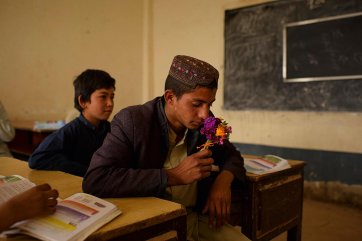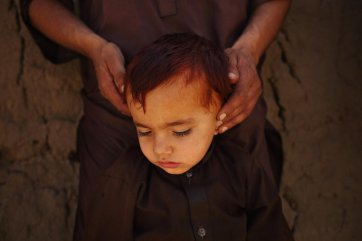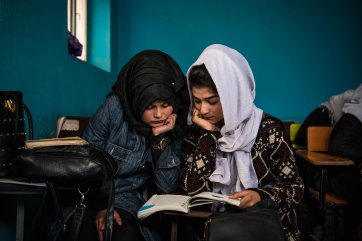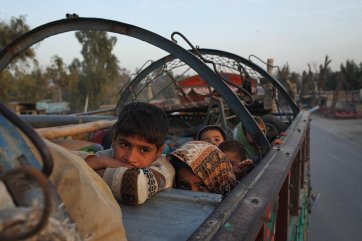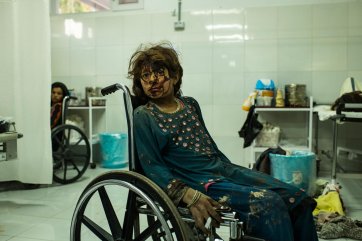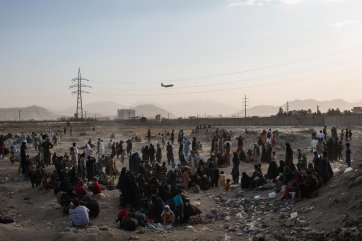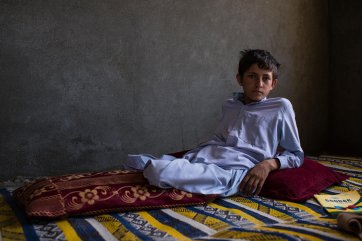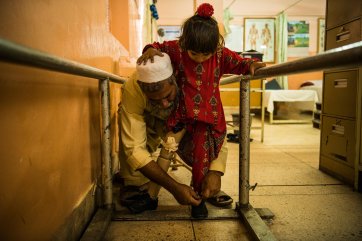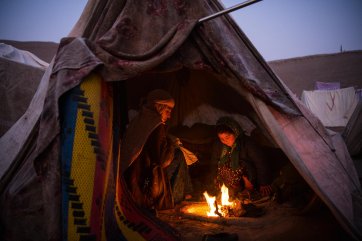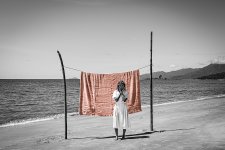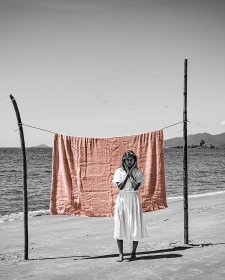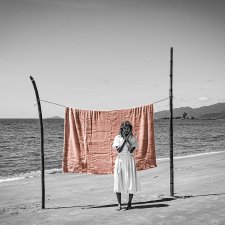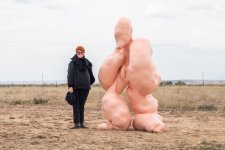At sunrise, a balloon seller makes his way through an informal settlement for families displaced by fighting in Afghanistan’s provinces, beside Kabul’s national cricket stadium, 2014 Andrew Quilty. © Andrew Quilty
Tim Hetherington’s articulate photograph of an exhausted American soldier in a Korengal Valley outpost was named 2008 World Press Photo of the Year. But it was another, by Balazs Gardi, of an Afghan man cradling a boy injured in a US airstrike in the same valley, which moved me more. I didn’t understand it at the time, but Gardi’s photo resonated because it was among a minority of remarkable images from the war in Afghanistan that portrayed innocence.
To me, it was the experience of Afghan non-combatants, those upon whom the war was imposed rather than the professional soldiers who chose to participate, whose stories most deserved to be told. And images like Gardi’s brought viewers as close to the war experience of Afghans as they were ever likely to get.
1 A student with flowers collected on the way to school in Sayedabad, Nad-I Ali district, Helmand, 2016. 2 Caught in the middle of a firefight between Taliban fighters and the ANSF in Kapisa province, Jawad’s father blocks his son’s ears to dull the sound of gunfire, mortars and rocket-propelled grenades erupting around them, 2014. Both Andrew Quilty.
© Andrew Quilty
I’d never imagined taking photographs like Gardi’s myself. Until that point I’d struggled to define the kind of themes to which I felt a genuine connection and often compensated by prioritising more aesthetic considerations. Even when the opportunity to accompany a friend and journalist to Afghanistan arose in 2013 my motivation wasn’t anything as noble as storytelling. It was far more ego-driven. I wanted to tick a box that would elevate me into the pantheon of journalists who had worked in ‘conflict zones’. With time and experience, however, the somewhat cynical reasons for which I’d come to Afghanistan became insignificant and were not those for which I decided to stay.
1 Parwan School Number 1, in Kabul, catered to marginalised young women, including those who were forbidden by education policy from attending school, 2019. 2 A family hurries to join a group granted access to the north-western gate of the airport, 2021. Both Andrew Quilty.
© Andrew Quilty
By then, with the will for war against the Taliban waning, access to the dwindling number of US soldiers and those of their allies almost completely ceased. The few journalists who were granted semi-regular access to the American combat forces who remained after 2014 reported in a way that ensured they maintained their favoured status. It was this shrinking access that forced me and many other journalists to report from the point of view of those living on the war’s fringe, many of whom ended up victims. (More than 70,000 civilians were killed and hundreds of thousands injured as a result of the war in the Afghanistan–Pakistan conflict zone between 2001 and 2021.)
1 An Afghan refugee family drives into Nangarhar province after being evicted from their home in Pakistan. They had lived there since fleeing the Soviet–Afghan war of the 1980s, 2015. 2 Nine-year-old Parwana was wounded in the air strike by an American A-10 warplane targeting Taliban fighters in Loy Manda, Nad-i Ali, 2018. Both Andrew Quilty.
© Andrew Quilty
Moreover, it was witnessing the experience of Afghans for whom neither innocence nor neutrality were enough to protect them from the war – in my first two years in Afghanistan – that compelled me to stay, and guided my focus for the six years that followed, like watching a father covering the ears of his four-year-old son after being caught in an ambush while walking home from a bazaar one morning; and meeting the grief-stricken family of Baynazar Mohammad Nazar, killed when the hospital in which he was being treated was destroyed by a US warplane.
1 Thousands of Afghans hoping to enter the airport waited day and night outside a gate controlled by a notorious CIA-controlled Afghan militia, 2021. 2 Twelve-year-old Shafiqullah from Nangarhar province lost both legs when an unexploded rocket-propelled grenade was brought home by a sibling and accidentally dropped. Four of the family were killed in the accident and seven children lost nine legs in total, 2018. Both Andrew Quilty.
© Andrew Quilty
Once the shrinking international military footprint exposed the Afghan forces’ over-reliance on their allies’ support, the return of the Taliban seemed inevitable – even if, before the signing of the Doha Agreement in 2021, I never imagined it would come before I had left Afghanistan. The photographs in This is Afghanistan represent vignettes of the hundreds of stories that led to that inevitability. No single image can possibly represent the array of Afghans’ experiences in the period covered here. Still, taking into account my own proclivities, the limits of the medium, and cultural, political and security impediments, combined, these photographs do make up a patchwork that represents a broad, imperfect portrait of time and place.
1 Four-year-old Marwa stands on her prosthetic leg for the first time with the help of her father at the orthopaedic centre in Nangarhar’s capital, Jalalabad, 2018. 2 A mother and daughter were among thousands forced to leave their homes for Badghis’ mprovincial capital Qala-i Naw when drought caused wheat crops to fail, 2018. Both Andrew Quilty.
© Andrew Quilty
This is an edited extract from Andrew Quilty’s This is Afghanistan: 2014–2021, published by The Miegunyah Press in 2023. Images and text © Andrew Quilty.

